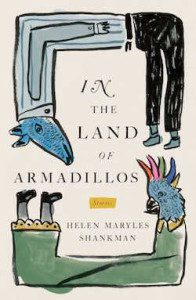
There are very few short story collections in the annals of Holocaust Literature. And aside from a handful of memoirs written by former Nazis and German officials, I have yet to see a work of fiction written by a Jew from the Nazi point of view. In The Land Of Armadillos by Helen Maryles Shankman—a short story collection written by a Jew—turns Nazi protagonists into rounded characters, giving them moments of kindness. Shankman doesn’t make the Nazis seem any less monstrous, just more human.
The stories circle the Jewish community in the Polish town of Wlodowa, on the eastern border next to Ukraine. Shankman blends surrealism with a fable-like knack for storytelling, yet the historical backdrop is real, based on events in 1942 German-controlled Wlodowa. Her stories are equally preoccupied with the Jew-Gentile relationship and the use of animals as both foil and metaphor.
In the title story, the Nazi officer Max Haas is stationed in Wlodowa, where he becomes Chief of Labor, assigned to organize jobs for the town’s Jews. In preparation for his family’s arrival, he enlists a Jewish artist, Tobias Rey, the author and illustrator of his son’s favourite picture book, In The Land Of Armadillos, to paint a mural on the boy’s bedroom wall. As the mural takes shape, Haas and the painter form a relationship. One minute, Haas is protecting Toby, encouraging a romantic relationship between Toby and the Jewish cook who works in Haas’s house. The next minute, he’s is whipping and shooting Jewish workers in the Market square. In one scene, he shoots Jews in their hospital beds; the next, he’s feeding Toby and promising him a warm winter coat. Shankman’s ability to align the reader with her Nazi protagonists, even for brief moments, is a skill in itself. Her hateful, yet somehow likeable characters keep dipping in and out of our favor.
As Haas grows more attached to Toby, he sets out to discover the reasons behind the artist’s deep sorrow. After speaking with Bianca, Toby’s translator and ex-sweetheart, a Gentile woman who was torn from him because of the anti-Jewish laws, Haas is shocked to learn that In The Land of Armadillos is not really a book meant for children:
“In The Land Of Armadillos is my son’s favorite storybook. I’ve read it many times.”
“You’ll know this, then. In the story, the armadillos live alongside the cockatoos for years, peacefully sharing the savannah, until an armadillo named Lazarus comes along and tells the others that cockatoos are bad, greedy creatures. The armadillos trample the blue cockatoos’ favourite food, the indigo plant, and then they drink up all the water. In town, they don’t let them rest in the trees, and they close down all the birdseed stores.”
Shankman frequently uses animals to portray the German-Jewish relationship, bringing the reader back to reality through fantasy. Haas tells Toby why he’s had a bad day:
“Lilo. My horse.” His voice cracked a little. “She fell and broke her leg. I had to put her down. I know, I know. It’s not like she’s a human being. But still…”
The horse was injured while being used to hunt and kill Jews.

The connecting characters become more poignant in “They Were Like Family To Me.” A priest is visiting present-day Wlodowa, probing for information on a local atrocity. But the priest has a secondary goal; he seeks information on his father, Willy Reinhart, who was Commandant of the Adompol Forced Labor Camp. By the end of the story, it’s not clear to him whether his father was a murderer.
“You should have noticed by now,” the priest says, “Sometimes a monster looks just like any other man.”
This notion extends in the next, and perhaps strongest story of the collection. “The Jew Hater” features Pavel Walczak, who takes every opportunity to inform on locals he suspects might be aiding or hiding Jews. He despises these locals, even though his friend reminds him that one of them, Soroka, made Pavel a new wagon harness and bridle after his had been destroyed. Soroka tells him to “pay him back whenever he could.”
A dying Partizan shows up at Pavel’s door in the middle of the night and forces him to hide and protect his little sister. What he demands of Pavel is dangerous; during the Nazi occupation, Poles were executed for hiding Jews. Pavel’s rough exterior starts to crack as he cares for the little girl. The story forays into magical realism when the girl tells Pavel that his dog communicates with her. On several occasions, the dog warns the girl that someone is coming to the house and that she should hide.
As the Jew hater tends to the little girl’s wounds, feeds her, and lies to protect her, we, as readers, begin to align ourselves with him. And we must ask ourselves; can we forgive Pavel for his atrocious acts of anti-Semitism? With this character, as with many others in the collection, we are left to wonder if forgiveness is permissible.
“A Decent Man” brings the collection full circle with Reinhart’s narrative. Until now he has been an enigmatic figure cobbled together in other stories. As Regional Commissioner, he is assigned to live in a castle at the edge of the woods. More an administrator than a soldier, Reinhart takes to the local population right away, admiring Soroka’s honesty and assuring protection to his Polish assistant, Drogalski. But he witnesses atrocities.
In the near distance, among the slim white trunks of birch trees, wave after wave of naked human beings filed into a pit, knelt on the bodies of their neighbors, and were shot in the back of the neck… He’d always known Jews, and as far as he could see, they were no different from anybody else.
Drogalski is beaten and murdered while Reinhart is away on vacation. When Soroka gives him the gory details, Reinhart vows to “save them. All of them. His workers, their families, their friends… Why the war in Eastern Europe turned men into monsters, he couldn’t say.”
But Willy Reinhart is not immune to the immense privilege given to German officials in German-occupied Poland. He loots furniture left behind by Jews transported to Sobibor, and he convinces himself that shooting an adolescent boy is justifiable.
What becomes of Reinhart and his Jews, namely Soroka the saddle maker to whom Reinhart grows quite attached? His legacy, along with Reinhart’s, carries into the last story. It flashes forward to 1989. On a Jewish heritage trip to Poland, the granddaughter of Soroka the saddle maker comes into possession of Reinhart’s personal journal. Reluctantly, she makes an appointment to meet with Reinhart’s grandson, who happens to be studying in New York, to hand over the journal to him. She shudders at his German accent, telling him:
“If you’re Jewish, there’s just something about a German accent that makes you shiver.” “But my grandfather protected your family.”
“Yes. My mother’s family. But on my father’s side, Einsatzgruppen wiped out his whole village.”
We’re left to ponder the Jewish-Gentile relationship, and we’re reminded that there were good Germans and evil Germans, some who committed atrocities, and some who turned a blind eye.
Shankman presents a typical German-occupied Jewish town in an atypical way: through the lens of several non-Jews and their individual transformations, or lack thereof. We come away with something new in literature—a full portrait of a war-torn Jewish town, where a nimble application of the magical gently veils the harsh realities.




